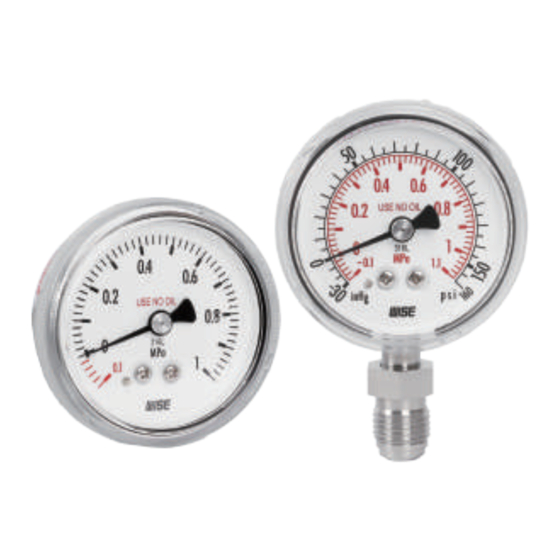
Table of Contents
Advertisement
Quick Links
Advertisement
Chapters
Table of Contents

Summarization of Contents
General Safety Warnings
Pressure Range Compliance
Do not apply pressure beyond the specified pressure range for safe operation.
Fluid Compatibility
Avoid using with corrosive measuring fluids to prevent damage or rupture.
Mechanical Stress Limits
Do not apply excessive load, vibration, or shock to the pressure gauge.
Temperature Operating Limits
Use within the specified operating temperature range to prevent damage.
Safe Removal Procedures
Close valve before removing instrument to prevent fluid discharge.
Fluid Handling Precautions
Use oil-free gauges with hydrocarbons or oxygen to prevent ignition risk.
Installation Adherence
Install according to instruction manual guidelines for proper function.
Product Modification Prohibition
Do not modify the product; consult manufacturer for repairs.
User Responsibility for Safety
Read manual carefully to prevent explosion or personal injury from incorrect use.
Product Characteristics
Cleanroom Assembly and Treatment
Assembly adjustment in Class 100 cleanroom with nitrogen gas; use No Oil and Water treatment.
Leak Testing and Packaging
Leak test with Helium; airtight packaging after nitrogen gas cleaning.
Gauge Specifications
Size and Accuracy Standards
Available sizes 35, 50, 63 mm with Grade A (ASME B40.1) accuracy.
Pressure Range and Operating Limits
Pressure range 0-25 MPa; operating pressure limits for static and pulsation.
Temperature and Connection Types
Operating temperature -40 to 100°C; various pressure connection options.
Part Identification and Operation
Operating Principle Explained
Details Bourdon tube expansion, rod movement, and sector gear interaction for pressure indication.
Handling and Storage Precautions
Transportation Safety
Handle with care to prevent damage from drops or impacts during transport.
Storage Environment
Store in a low humidity, vibration, and dust-free environment.
Package Opening
Handle packages carefully when opening and removing products.
Mounting Guidelines
Installation Location Selection
Choose locations with minimal moisture, vibration, dust, and corrosive gas.
Environmental Condition Avoidance
Avoid areas exceeding specified ambient temperatures, lightning, steam, and direct sunlight.
Piping and Connection
Use flexible tubing for inlet piping; use specified spanner for connections, avoid holding the case.
Maintenance and Usage Precautions
Operating Pressure and Change
Use below 75% of scale, avoid exceeding range, and prevent sudden pressure changes.
Pulsating Pressure Mitigation
Install dampeners or gauge protectors for pulsating or impact pressure conditions.
Lubrication and Inspection
Do not lubricate moving parts; perform regular inspections every 6 months.
Error Diagnosis and Resolution
Inspect products with significant indicator errors, addressing causes like wear or corrosion.














Need help?
Do you have a question about the P820 and is the answer not in the manual?
Questions and answers